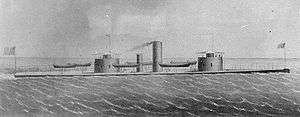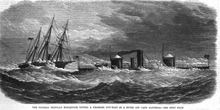USS Monadnock (1863)
The first USS Monadnock, a twin‑screw, wooden‑hull, double-turreted, ironclad monitor was laid down at the Boston Navy Yard in Charlestown, Massachusetts in 1862. The vessel was launched on 23 March 1863; and commissioned at the Boston Navy Yard on 4 October 1864, Captain John M. Berrien in command. It was named after Mount Monadnock, a mountain in southern New Hampshire.
 A lithograph of USS Monadnock | |
| History | |
|---|---|
| Name: | USS Monadnock |
| Namesake: | Mount Monadnock |
| Builder: | Boston Navy Yard |
| Laid down: | 1862 |
| Launched: | 23 March 1863 |
| Commissioned: | 4 October 1864 |
| Decommissioned: | 30 June 1866 |
| Fate: | Broken up, 1874 |
| General characteristics | |
| Class and type: | Miantonomoh-class monitor |
| Displacement: | 3,295 long tons (3,348 t) |
| Length: | 250 ft (76 m) |
| Beam: | 53 ft 8 in (16.36 m) |
| Draft: | 12 ft 3 in (3.73 m) |
| Installed power: |
|
| Propulsion: |
|
| Speed: | 9 knots (17 km/h; 10 mph) |
| Complement: | 130 officers and ratings |
| Armament: | 2 × twin 15 in (380 mm) smoothbore Dahlgren guns |
| Armor: |
|
Background
The only monitor of the Monadnock class to see action during the Civil War, Monadnock was designed by Chief of the Bureau of Construction and Repair John Lenthall. Lenthall actually designed four monitors at that time. Monadnock and USS Agamenticus were the first and are considered the two Monadnock-class vessels. Lenthall altered the designs of the next two, USS Miantonomoh and USS Tonawanda, and dubbed them the Miantonomoh class. Because of the similarities between the two classes they are sometimes referred to collectively as the Miantonomoh class.
_vibrating-lever_engine.jpg)
Monadnock used powerful steam engines designed by Chief of Steam Engineering, Benjamin F. Isherwood. Her hull design was also much more streamlined than monitors designed by John Ericsson. Unfortunately, her internal frames were only 4.5 in (11 cm) oak and like Lenthall's USS Roanoke conversion, the weight of her turrets weakened the structural integrity of the hull and she was prone to rotting and cracking.
Service history
Civil War
In service, Monadnock steamed to Norfolk, Virginia, and there Commander Enoch Greenleafe Parrott took command on 20 November 1864. On 13 December she departed Norfolk for the assault against Fort Fisher. She joined Rear Admiral David D. Porter's North Atlantic Blockading Squadron on 15 December, and four days later departed Beaufort, North Carolina, to join the Union fleet massed to attack Confederate defenses on the Cape Fear River. On the morning of Christmas Eve, she closed the entrance of the river, guarded by Fort Fisher. At less than 1,200 yards (1,100 m) from shore she began bombarding the fortification and continued throughout the day. The following morning she resumed shelling as 2,000 Army troops under the command of General Benjamin F. Butler landed north of the fort. However, after coming close to the fort, the troops were pulled back and reembarked in the landing boats.
The attack was renewed 13 January 1865. Through the 15th, Monadnock again shelled the fort's defenses, disabling many of the guns. Firing continued until the last gun on the sea face was silenced, well after the troops, under Major General Alfred Terry, and sailors and Marines had launched their final and successful assault. During the action, perhaps the largest amphibious operation in American history prior to World War II, Monadnock was struck five times. One of Monadnock's sailors, Quartermaster William Dunn, was awarded the Medal of Honor for his actions in the Fort Fisher engagements.[1]
Having aided in the closing of the port of Wilmington, North Carolina, the South's last important link in the overseas supply lifeline, Monadnock turned toward Charleston, South Carolina. On 19 February, while still in the Charleston area; she sent a volunteer crew to take possession of blockade runner Deer.
After a stay at Port Royal, South Carolina, she steamed to Hampton Roads 15 March. On 2 April, she steamed up the James River to support the final assault on Richmond, Virginia and then assisted in clearing the river of torpedoes to allow safe passage to the fallen Confederate capital. Returning to Hampton Roads 7 April, she sailed out into the Atlantic on 17 April, en route to Havana, where she kept watch over CSS Stonewall. Back at Norfolk by 12 June, she entered the Philadelphia Navy Yard on 20 June to fit out for her cruise to the west coast.
Cruise around South America

Monadnock departed Philadelphia, Pennsylvania on 5 October; with USS Vanderbilt, USS Tuscarora, and USS Powhatan. Temperatures in the fire-room ranged from 120 to 140 degrees Fahrenheit (49–60 degrees Celsius) near the equator.[2] Stokers collapsed daily from heat prostration and special inducements of extra pay and spirits were offered to men to take their place.[2] During part of the trip, her crew rigged a single square sail and jib which increased speed by 1.5 knots (2.8 km/h; 1.7 mph).[2] After stops at numerous South American ports, she transited the Strait of Magellan and arrived at Valparaíso, Chile while a Spanish squadron was bombarding the town during the Chincha Islands War.[2] Peru later purchased American monitors Oneota and Catawba for use in the War of the Pacific.[2] Monadnock's arrival at Acapulco coincided with Mexican attempts to end French intervention in Mexico.[2] The squadron continued on to San Francisco, anchoring off that city on 21 June 1866. On 26 June she proceeded to Vallejo, California and entered the Mare Island Navy Yard where she decommissioned 30 June.
In 1874 her wooden hull was broken up as part of a program to "rebuild" Civil War era monitors into modern ones. In fact, she was replaced by a completely new ship, which was also named Monadnock.
References
- "Medal of Honor Recipients – Civil War (A–L)". Medal of Honor Citations. United States Army Center of Military History. 26 June 2011. Retrieved 2 February 2013.
- Alden, John D., CDR USN "Monitors 'Round Cape Horn" United States Naval Institute Proceedings September 1974 pp.78–82
- This article incorporates text from the public domain Dictionary of American Naval Fighting Ships. The entry can be found here.
- Canney, Donald L. (1993). The Old Steam Navy: The Ironclads, 1842–1885. 2. Annapolis, Maryland: Naval Institute Press. ISBN 0-87021-586-8.
- Olmstead, Edwin; Stark, Wayne E.; Tucker, Spencer C. (1997). The Big Guns: Civil War Siege, Seacoast, and Naval Cannon. Alexandria Bay, New York: Museum Restoration Service. ISBN 0-88855-012-X.
- Silverstone, Paul H. (2006). Civil War Navies 1855–1883. The U.S. Navy Warship Series. New York: Routledge. ISBN 0-415-97870-X.